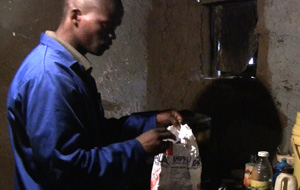The World Journalism Project
Department of Newspaper and Online Journalism
The S.I. Newhouse School of Public Communications
About this story
Author: Ashley Kang
Date: January 2011
People: Siyanda Antoni

Siyanda Antoni works in his kitchen preparing the traditional African salad. | Photo by Mackenzie Reiss
Data points: According to an article in the Grocott’s Mail local newspaper, 25% of the population of Grahamstown grows its own food.
What’s to eat? Often, African salad
By: Ashley Kang
The meal most often prepared by Siyanda Antoni is known in English as African salad.
This simple dish — known in Xhosa as Umphokoqo (pronounced Um-Po-Ko Ko-Un, with the last Ko produced with a tongue click) — is prepared by boiling maize meal and is nothing like a typical American salad but more like a simple porridge.
In the township, the 23-year-old Antoni and many others eat this porridge for several meals each day.
To prepare, he begins by lighting a single-burner stove that uses paraffin, which is a liquid fuel still widely used in the township for cooking.
(The use of paraffin in the township’s tightly crowded homes is an extreme fire hazard — paraffin stoves may ignite clothing and bedding. Recent public service announcements by the Paraffin Safety Association of Southern Africa have emphasized that poor storage of paraffin, and misuse of it, frequently causes fires.)
After securely closing and putting away the paraffin container, Antoni lights both sides of the stove. He adds two cups of water with salt to a pot that’s placed on the flame and brought to a boil. As he waits for the water to boil, Antoni measures maize meal into a bowl.
The one bowl Antoni owns and uses to make African salad holds special meaning. It was given to him during his Ubudoda ceremony. “They give me this bowl when I was coming from the bush — to be a man.”
Once the water begins to boil, Antoni pours the maize meal into the pot. “You must not pour [all at once], but just a little at a time,” Antoni explains. “Make sure no waste is left,” he adds, as he scrapes every last grain into the pot.
The maize is cooked for about five minutes, until it plumps up. Then the heat is reduced and the mixture is stirred. “Push back, and stir,” Antoni says as he spreads the mixture from the center to the sides of the pot. Then the pot is removed from the flame and the mixture is stirred on the counter as it cools a bit. It’s placed back on the stove to heat for a minute or so more; this stirring and cooling process is done three times.
In the final cooling process, Antoni places the mixture in his bowl and repeatedly tosses the cooked meal into the air. As he uses his wrists to shake the bowl up and down, his head rhythmically moves to this motion. The last step: Add milk to further cool down the mixture and transform it to a soupy porridge.
Antoni advises how to properly eat African salad.
“According to our traditional African ways,” he says, “a man when he is eating, he must sit down and eat like a man.”

































